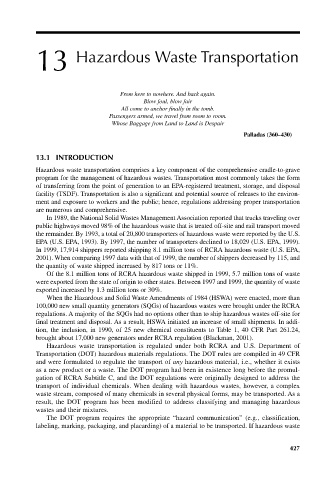Page 456 - Materials Chemistry, Second Edition
P. 456
CAT3525_C13.qxd 1/27/2005 12:30 PM Page 427
13 Hazardous Waste Transportation
From here to nowhere. And back again.
Blow foul, blow fair
All come to anchor finally in the tomb.
Passengers armed, we travel from room to room.
Whose Baggage from Land to Land is Despair
Palladas (360–430)
13.1 INTRODUCTION
Hazardous waste transportation comprises a key component of the comprehensive cradle-to-grave
program for the management of hazardous wastes. Transportation most commonly takes the form
of transferring from the point of generation to an EPA-registered treatment, storage, and disposal
facility (TSDF). Transportation is also a significant and potential source of releases to the environ-
ment and exposure to workers and the public; hence, regulations addressing proper transportation
are numerous and comprehensive.
In 1989, the National Solid Wastes Management Association reported that trucks traveling over
public highways moved 98% of the hazardous waste that is treated off-site and rail transport moved
the remainder. By 1993, a total of 20,800 transporters of hazardous waste were reported by the U.S.
EPA (U.S. EPA, 1993). By 1997, the number of transporters declined to 18,029 (U.S. EPA, 1999).
In 1999, 17,914 shippers reported shipping 8.1 million tons of RCRA hazardous waste (U.S. EPA,
2001). When comparing 1997 data with that of 1999, the number of shippers decreased by 115, and
the quantity of waste shipped increased by 817 tons or 11%.
Of the 8.1 million tons of RCRA hazardous waste shipped in 1999, 5.7 million tons of waste
were exported from the state of origin to other states. Between 1997 and 1999, the quantity of waste
exported increased by 1.3 million tons or 30%.
When the Hazardous and Solid Waste Amendments of 1984 (HSWA) were enacted, more than
100,000 new small quantity generators (SQGs) of hazardous wastes were brought under the RCRA
regulations. A majority of the SQGs had no options other than to ship hazardous wastes off-site for
final treatment and disposal. As a result, HSWA initiated an increase of small shipments. In addi-
tion, the inclusion, in 1990, of 25 new chemical constituents to Table 1, 40 CFR Part 261.24,
brought about 17,000 new generators under RCRA regulation (Blackman, 2001).
Hazardous waste transportation is regulated under both RCRA and U.S. Department of
Transportation (DOT) hazardous materials regulations. The DOT rules are compiled in 49 CFR
and were formulated to regulate the transport of any hazardous material, i.e., whether it exists
as a new product or a waste. The DOT program had been in existence long before the promul-
gation of RCRA Subtitle C, and the DOT regulations were originally designed to address the
transport of individual chemicals. When dealing with hazardous wastes, however, a complex
waste stream, composed of many chemicals in several physical forms, may be transported. As a
result, the DOT program has been modified to address classifying and managing hazardous
wastes and their mixtures.
The DOT program requires the appropriate “hazard communication” (e.g., classification,
labeling, marking, packaging, and placarding) of a material to be transported. If hazardous waste
427

